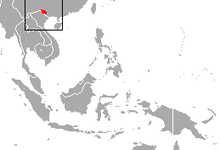Eastern black crested gibbon
The eastern black crested gibbon (Nomascus nasutus), also known as the Cao-vit black crested gibbon or the Cao-vit crested gibbon, is a species of gibbon from southeast China and northern Vietnam.
| Eastern black crested gibbon | |
|---|---|
| Scientific classification | |
| Kingdom: | Animalia |
| Phylum: | Chordata |
| Class: | Mammalia |
| Order: | Primates |
| Suborder: | Haplorhini |
| Infraorder: | Simiiformes |
| Family: | Hylobatidae |
| Genus: | Nomascus |
| Species: | N. nasutus |
| Binomial name | |
| Nomascus nasutus (Künckel d'Herculais, 1884) | |
 | |
| Eastern black crested gibbon range | |
From the 1960s until the 2000s there had been no confirmed sightings of the eastern black crested gibbon and it was thought to be possibly extinct. In 2002 a small population was rediscovered by two FFI's biologists (La Quang Trung and Trinh Dinh Hoang) in the Trùng Khánh District, Cao Bằng Province, in northeast Vietnam.[2] In 2005 it was estimated that this population included about 35-37 individuals, and about 10 remain just across border in Jingxi County, Guangxi, China.[1] It was thought to be extinct in China before the species was re-discovered by members of Kadoorie Conservation China.[3]
The eastern black crested gibbon is one of the rarest and most critically endangered primates in the world. This status has resulted from deforestation of its habitat, encroachment, and poaching. It is considered to be one of "The World's 25 Most Endangered Primates."[4]
Taxonomy
The eastern black crested gibbon is classified as separate from other crested gibbons based on molecular data, fur coloration, and differences in vocal communication. Previously it had been considered conspecific with the Hainan black crested gibbon or as a subspecies of the black crested gibbon.[1] Until the sequencing of the mitochondrial cytochrome b gene the Hainan black crested gibbon was thought to be Nomascus nasutus hainanus, a subspecies of eastern black crested gibbon. The researchers proposed that the genetic separation showed it was a distinct species.[5]
References
- Bleisch, B. & Geissmann, T. (2008). "Nomascus nasutus". IUCN Red List of Threatened Species. 2008: e.T41642A10526189. doi:10.2305/IUCN.UK.2008.RLTS.T41642A10526189.en.
- La Quang Trung; Trinh Dinh Hoang (2002). "Report on survey of eastern black crested gibbon (Nomascus sp. cf.nasutus) in Trunh Khanh District, Cao Bang Province". Fauna & Flora International Indochina Programme. Hanoi, Vietnam.
- Chan BPL, Tan XF and Tan WJ, 2008. Rediscovery of the Critically Endangered Eastern Black CrestedGibbon Nomascus nasutus (Hylobatidae)in China, with preliminary notes on population size, ecology and conservationstatus. Asian Primates Journal 1(1): 17-25. http://www.primate-sg.org/storage/PDF/APJ1.1.nasutus.pdf%5B%5D
- Mittermeier, R.A.; Wallis, J.; Rylands, A.B.; Ganzhorn, J.U.; Oates, J.F.; Williamson, E.A.; Palacios, E.; Heymann, E.W.; Kierulff, M.C.M.; Long Yongcheng; Supriatna, J.; Roos, C.; Walker, S.; Cortés-Ortiz, L.; Schwitzer, C., eds. (2009). "Primates in Peril: The World's 25 Most Endangered Primates 2008–2010" (PDF). Illustrated by S.D. Nash. Arlington, VA.: IUCN/SSC Primate Specialist Group (PSG), International Primatological Society (IPS), and Conservation International (CI): 1–92. ISBN 978-1-934151-34-1. Archived from the original (PDF) on 2011-07-23. Cite journal requires
|journal=(help) - Roos, C.; Thanh, V. N.; Walter, L.; Nadler, T. (2007). "Molecular systematics of Indochinese primates" (PDF). Vietnamese Journal of Primatology. 1: 41–53.
| Wikimedia Commons has media related to Nomascus nasutus. |
